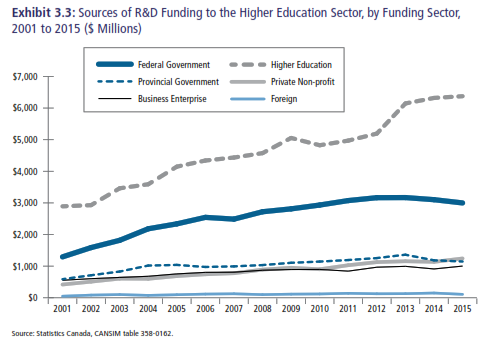People are asking why I haven’t talked about the Naylor Report (aka the Review of Fundamental Science) yet. The answer, briefly, is i) I’m swamped ii) there’s a lot to talk about in there and iii) I want to have some time to think it over. But I did have some thoughts about chapter 3, where I think there is either an inadvertent error or the authors are trying to pull a fast one (and if it’s the latter I apologize for narking on them). So I thought I would start there.
The main message of chapter 3 is that the government of Canada is not spending enough on inquiry-driven research in universities (this was not, incidentally, a question the Government of Canada asked of the review panel, but the panel answered it anyway). One of the ways that the panel argues this point is that while Canada has among the world’s highest levels of Research and Development in the higher education sector – known as HERD if you’re in the R&D policy nerdocracy – most of the money for this comes from higher education institutions themselves and not the federal government. This, that say, is internationally anomalous and a reason why the federal government should spend more money.
Here’s the graph they use to make this point:
Hmm. Hmmmmm.
So, there are really two problems here. The first is that HERD can be calculated differently in different countries for completely rational reasons. Let me give you the example of Canada vs. the US. In Canada, the higher education portion of the contribution to HERD is composed of two things: i) aggregate faculty salaries times the proportion of time profs spend on research (Statscan occasionally does surveys on this – I’ll come back to it in a moment) plus ii) some imputation about unrecovered research overhead. In the US, it’s just the latter. Why? Because the way the US collects data on HERD, the only faculty costs they capture are the chunks taken out of federal research grants. Remember, in the US, profs are only paid 9 months per year and at least in the R&D accounts, that’s *all* teaching. Only the pieces of research grant they take out as summer salary gets recorded as R&D expenditure (and also hence as a government-sponsored cost rather than a higher education-sponsored one).
But there’s a bigger issue here. If one wants to argue that what matters is the ratio of federal portion of HERD to the higher-education portion of HERD, then it’s worth remembering what’s going on in the denominator. Aggregate salaries are the first component. The second component is research intensity, as measured through surveys. This appears to be going up over time. In 2000, Statscan did a survey which seemed to show the average prof spending somewhere between 30-35% of their time on research. A more recent survey shows that this has risen to 42%. I am not sure if this latest co-efficient has been factored into the most recent HERD data, but when it does, it will show a major jump in higher education “spending” (or “investment”, if you prefer) on research, despite nothing really having changed at all (possibly it has been and it is what explains the bump seen in expenditures in 2012-13)
What the panel ends up arguing is for federal funding to run more closely in tune with higher education’s own “spending”. But in practice what this means is: every time profs get a raise, federal funding would have to rise to keep pace. Every time profs decide – for whatever reasons – to spend more time on research, federal funds should rise to keep pace. And no doubt that would be awesome for all concerned, but come on. Treasury Board would have conniptions if someone tried to sell that as a funding mechanism.
None of which is to say federal funding on inquiry-driven research shouldn’t rise. Just to say that using data on university-funded HERD might not be a super-solid base from which to argue that point


 Tweet this post
Tweet this post
